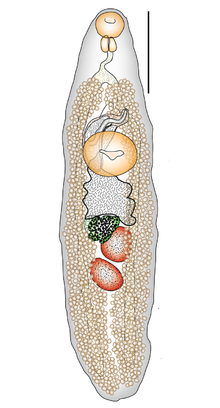Hamacreadium cribbi
| Hamacreadium cribbi | |
|---|---|

| |
| Scientific classification | |
| Kingdom: | |
| Phylum: | Platyhelminthes
|
| Class: | |
| Order: | |
| Family: | |
| Genus: | |
| Species: | H. cribbi
|
| Binomial name | |
| Hamacreadium cribbi | |
Hamacreadium cribbi is a species of digenean, parasitic in the lethrinid fish Lethrinus miniatus. The species was collected off New Caledonia.
Morphology[]
H. cribbi is characterised by the size of its eggs which tend to be larger [72–93 (84) vs 54–81 (56) µm long] than those of other species of Hamacreadium. Other characteristics, such as body size and shape and internal ratios, differentiate H. cribbi from other species.[1]
Host[]

The host of H. cribbi is the Sweetlip emperor, Lethrinus miniatus. The worms were found in the digestive tract.
This species was reported from this host species in 2010 under the name Neolebouria sp. A.[2] The following species as hosts of Neolebouria sp. A: the Spotcheek Emperor Lethrinus rubrioperculatus; the Pacific Yellowtail Emperor Lethrinus atkinsoni, the Drab Emperor , and the Slender Emperor, . However, the description of H. cribbi [1] was based solely on the worms from L. miniatus, and worms from the other hosts may differ, possibly at the specific level.
Etymology[]
This species was named for "Tom Cribb of the University of Queensland, the pre-eminent digenean taxonomist of the Indo-Pacific Region".[1]
References[]
- ^ a b c d Bray, Rodney A.; Justine, Jean-Lou (2016). "Hamacreadium cribbi n. sp. (Digenea: Opecoelidae) from Lethrinus miniatus (Forster) (Perciformes: Lethrinidae) from New Caledonian waters". Systematic Parasitology. 93 (8): 761–770. doi:10.1007/s11230-016-9662-8. ISSN 0165-5752. PMC 5023753. PMID 27638731.

- ^ Justine, J.-L., Beveridge, I., Boxshall, G. A., Bray, R. A., Moravec, F. & Whittington, I. D. 2010: An annotated list of fish parasites (Copepoda, Monogenea, Digenea, Cestoda and Nematoda) collected from Emperors and Emperor Bream (Lethrinidae) in New Caledonia further highlights parasite biodiversity estimates on coral reef fish. Zootaxa, 2691, 1-40. Open-Access PDF

- Parasitic helminths of fish
- Fauna of New Caledonia
- Animals described in 2016